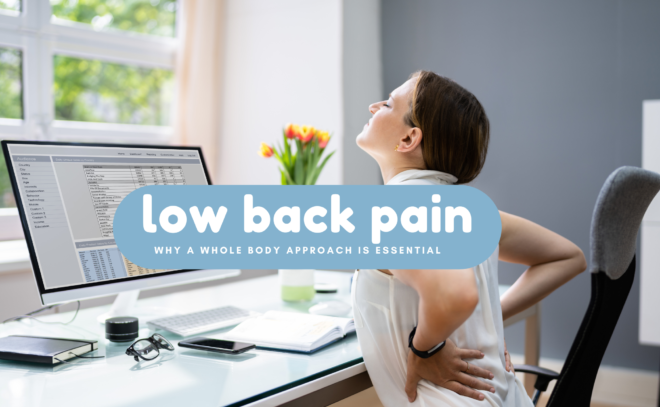Treating Low Back Pain – Why a Whole Body Approach is Essential

Low back pain is a huge issue globally. Up to 24% of adults world-wide suffer from chronic low back pain (1 in 4 people!) and 84% of adults will have low back pain at some point in their life. Although there is a large range of causes, 90% of low back pain is biomechanical.
Biomechanical low back pain is pathology of the soft tissues, intervertebral discs and spine. This is often linked with forced time off work, disability, decreased quality of sleep and poor mental health.
That being said, what is the best way to resolve low back pain and build a more resilient low back to decrease frequency and intensity of occurrence in the future?
A comprehensive, whole body approach.
You cannot examine and treat one body part in isolation. I mean, you can, but you will not get the lasting results and improved function you are most likely looking for. The whole kinetic chain needs to be examined.
Some examples of looking up and down the kinetic chain are an extremely stiff thoracic spine and hip joints. The thoracic spine is supposed to rotate while we walk, extend when we reach overhead, etc. Hip joints are a ball and socket joint (like the shoulder) and we should move around this joint when bending, squatting, stepping etc. When these two areas are not functioning properly, the lumbar spine often has to compensate.
Compensation may look like repetitively bending in your lumbar spine instead of hinging at your hips to bend. Your lumbar spine is not built for a lot of repetitive flexion; the vertebra and surrounding structures are more geared towards stability. We want the lumbar spine to become rigid and stable so we can generate power to move our extremities. ALL movement originates in our core!
On top of looking at movement patterns and range of motion, a thorough exam should also include lifestyle factors. How are you sleeping, eating, moving, or not moving? Are you stressed or have other psychosocial factors that can be affecting your body’s ability to heal itself?
What is your history? Have you had low grade back pain for a long time, but suddenly out of the blue a benign movement causes a debilitating injury? See my other blog post “The Tale of the But I Didn’t Do Anything Injury”.
A seemingly minor thing that has a very large impact is breathing. It’s important to breathe using your diaphragm (the dome shaped muscle under your lungs) as opposed to breathing with your chest and shoulders. We want to use more capacity of our lungs and have expansion of our ribs outwards as we inhale. This impacts our backs as our diaphragm is the top of our core (the bottom being the pelvic floor). We need to be able to properly utilize our core for proper movement patterns therefore diaphragmatic breathing is essential for a healthy low back.
This is really just scratching the surface, but hopefully it is apparent that when helping low back pain we have to look above, below and around it to properly address it.
“You’ve only got one mind and one body. And it’s got to last a lifetime.”
-Warren Buffet